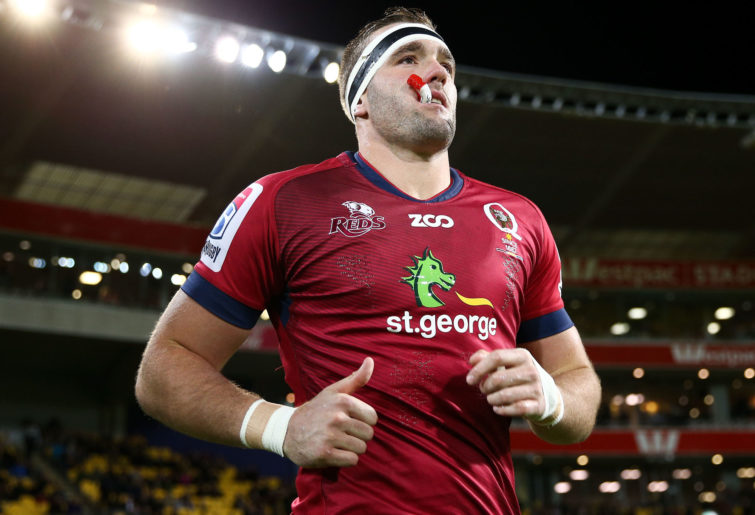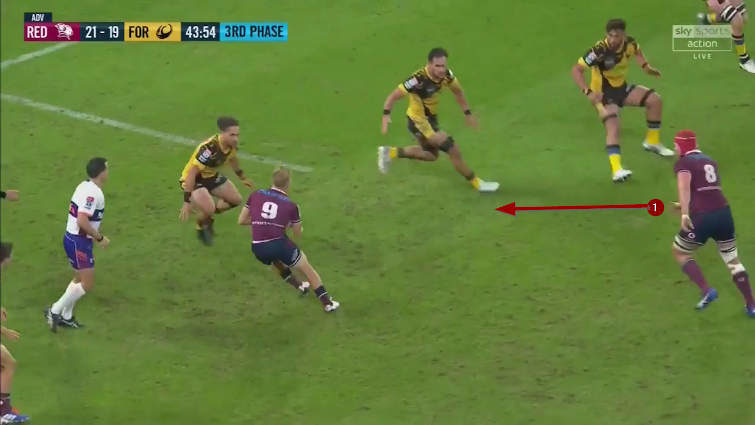Towards the end of May, the COVID-19 break claimed its highest-profile victims in Australian rugby. Instead of contracting the virus itself, the Queensland trio of Izack Rodda, Harry Hockings and Isaac Lucas experienced its economic impact first hand.
All three, who coincidentally shared the same agent in Anthony Picone, refused to accept a 60 per cent pay cut brokered by Rugby Australia and the Rugby Union Players Association in response to the crisis.
All three would have had a part to play, greater or lesser, in Australia’s 2023 World Cup planning. Both Rodda and Lucas were on long-term deals with Queensland and Australian rugby, while RA were looking to sew up Hockings’ future for the next three years.
Scott Johnson was frank about his disappointment at losing such key players in his vision.
“For mine, if we’re talking about disappointment, they’re three guys of national interest,” Johnson said.
“Two of them we signed long contracts for and the third we were in the process of, he had an offer on the table for an extensive period. It’s disappointing because they’re front of mind when it comes to the bigger picture.
“We have a high respect for them as rugby players, we think they are part of the solution of the future going forward.
“We showed commitment from our end because we value their talent.
“So that’s where the disappointment lies to me because we had a good plan going in place at the moment with youthful people that were committed.”
While Lucas and Hockings were development projects, Rodda represented an immediate loss. With both Rory Arnold and Adam Coleman having left for European shores after the 2019 World Cup, Rodda was the senior second-rower in Australia and could have been contemplating a 100-Test international career. He already had 25 Wallaby caps at the age of 23.

Izack Rodda. (Hagen Hopkins/Getty Images)
What had been a fertile delta in maroon second-row stocks, with Rodda and Hockings jostling for playing time with other young prospects like Lukhan Salakaia-Loto, Angus Blyth and rising under 20s star Michael Wood, suddenly became a barren wasteland.
With Blyth out with a shoulder injury, number 8 Angus Scott-Young was press-ganged into emergency lock duty against the Force on Friday night as Brad Thorn scraped the barrel for big men.
In the event, it worked out rather well. Regular readers will know I have been arguing for a permanent move of Lukhan Salakaia-Loto into the second row for well over a year, with Liam Wright shifting to number 6 and Fraser McReight coming in on the openside flank. Now it appears that the pennies have dropped in Brad Thorn’s eyes, too.
This is the optimal arrangement in the Reds’ back five forwards, and it may, in time, become the best solution for the Wallabies. With the enforced departure of Rodda and Hockings, Salakaia-Loto has at long last been moved to the position in which he has a shot to become a genuine Test player. Ditto Wright, and a couple of seasons down the line, McReight.
So why are players like Salakaia-Loto and Wright now looking more effective in their new roles? Let’s take a look at the detail.
Despite facing a lineout called by ex-All Black Jeremy Thrush, the Reds dominated this facet of set-piece play. In the process, Wright demonstrated a lineout ability on both sides of the throw which had been missing in his outings at number 7.
He was a major target on Reds ball, winning five throws in the course of the match:
In the build-up to the third Reds try of the game, Wright not only gets quick elevation into the air, he shows some finesse in the release of the ball to his scrumhalf at just the right moment.
But it was his performance in lineout defence which was the true revelation. He won three Force throws by himself, and between them, he and Salakaia-Loto forced two other turnovers with constant pressure:
The Reds profited from jacking up two lineout competitors consistently on the Western Force throw – one pod on Wright at the front, the other on Lukhan at the back:

It worked for them until the very end of the contest, and with the game still on the line:
Impacts in other areas of the game were less obvious, but every bit as important. At the end of March, I examined some of the defensive failures of the Reds back row with Lukhan Salakaia-Loto starting at number 6 and Liam Wright at 7. Wright tends to stick too close to the tackle zone and Salakaia-Loto finds himself in trouble on occasions when he is asked to defend out wide, especially on the short side.
With the latter now operating as a tight forward rather than a number 6, he is able to wrap around into the middle of the field after the first ruck, rather than remaining on the short side edge defending next to a back:
The impression is that Lukhan Salakaia-Loto is at last being assigned a defensive task for which he is well suited, driving the ball-carrier back with power in traffic.
While he wrapped around to the openside to make big hits on big men, Wright patrolled the short side effectively from lineout:
When the ball comes back to the blindside, right winger Chris Feauai-Sautia rushes out on to the second pass and Wright is running inside him to win the turnover when the ball-carrier drops to the ground. This is a play which could not have been duplicated with Salakaia-Loto defending the short side.
The sense of greater cohesion extended to the work of the back five forwards on attack, too:
With two mobile men at 6 and 7 in Wright and Fraser McReight, the Reds are able to get the ball wider, quicker from this attacking scrum. McReight heads up the cleanout at the first ruck, while his captain is quick enough to get around from the blindside of the set-piece to lead the cleanout at the second:

This has another vital benefit. The Reds’ heaviest ball-carrier (number 8 Harry Wilson) has not been used up as a runner or in support at either of the first two rucks, and is therefore still available for duty on the toughest carrying phase, when play bounces back in from a sideline and the defence is ready to tee off on the runner:

The interplay between the back row and Salakaia-Loto was also well-oiled and harmonious from attacking lineouts:
In the first example, Wright lifts for Salakaia-Loto’s catch and McReight works the ball off a false drive to set up Wilson’s run. In the second, the favour is returned with Salakaia-Loto lifting for Wright and McReight again working Wilson across the advantage line on an angled run.
Summary
It is by no means perfect, but it’s a lot better at Ballymore post-pandemic compared to pre-COVID Super Rugby. Where the Reds languished in tenth spot with two wins and five losses in the first iteration of the tournament, they are now undefeated in the first three rounds of Super Rugby AU.
The irony is that improvement has coincided with the departure of three current or potential Wallabies in Izack Rodda, Harry Hockings and Isaac Lucas. In the case of selection in the back five forwards, the upswing in fortunes has been triggered by the absence of Rodda and Hockings.
Brad Thorn has been forced to pick Lukhan Salakaia-Loto in the second row, and that has enabled Liam Wright to shift to number 6, with last year’s Junior Wallabies captain, Fraser McReight, starting at number 7.

Lukhan Salakaia-Loto. (Photo by Bradley Kanaris/Getty Images)
That has, in turn, enabled Wright to showcase a lineout ability which had been hitherto absent at openside, and which could conceivably benefit both his province and his country.
Salakaia-Loto has at last been given the opportunity to defend in areas where he can fully deploy his power and enjoy himself, rather than endure the recurring nightmare of backs running at him on the edge in space.
On attack, the Reds are also able to achieve width more quickly with two opensides in support, and reserve the threat of Harry Wilson for a moment where his contribution can really make a difference.
They say that every cloud has a silver lining, and that may just turn out to be true for two New Zealanders coaching professionally in Australia – not just Brad Thorn at the Reds, but Dave Rennie with the national team. Australia is certainly due a lightning strike of good fortune, and one may just have flickered out of the deep, deep blue.

































































































